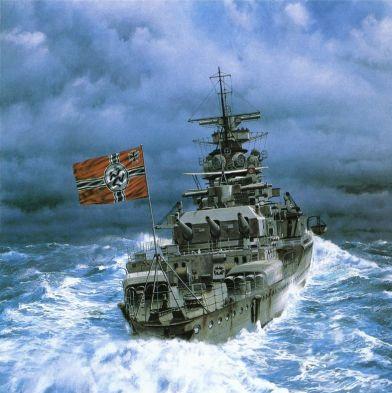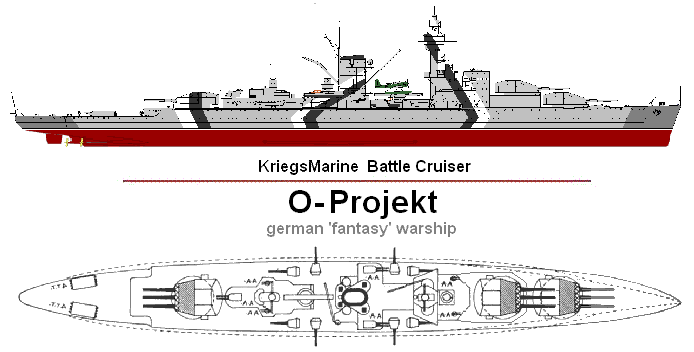The Navy Field game is an interpretation and/or a simulation of World War II naval combat. It contains MANY abstractions and some speculative ships and weapons. The visual designs of the ships, guns, and planes are very detailed. However, characteristics of some of the units in the game are sometimes historically inaccurate. 
Kreigsmarine Battlecruiser - O projekt ==========================================================================

Oceania Projekt
------------------------------------------------
The Oceania Projekt is a continuation of the of the Deutschland class and Panzerschiffe Projekt series.
The prototype of the Panzerschiffe was ordered under the 1929 Program for the Reichsmarine of the Weimar Republic. Germany was limited by the Treaty of Versailles to building only replacements for her six predreadnought coast defense battleships, and they were to displace only 10,000 tons and have guns no larger than 11in (28cm) caliber. The idea was to limit Germany to nothing more than coastal defence ships - which could not challenge the major naval powers of Britain, France and the United States. However, a number of technical innovations were used by Germany to still build a formidable warship within this restricted weight class; among them were the large-scale use of welding to join hull components together (as opposed to the then-standard rivets), triple-gun main armament turrets (which had first been used by the Austro-Hungarian Navy in battleships in the Tegetthoff class of 1912), and the use of diesel engines for propulsion. Even so, all members of the class were well over that weight limit (first constructed as 10,600 tons, later enlarged to 12,100 tons), although for political reasons their announced displacement was always misrepresented as the 10,000 tons of the Treaty limit.
The principal feature of the Deutschland class Panzerschiffe design was that it had guns of large enough calibre—280 mm (11 inches)—to out-gun almost any enemy cruiser fast enough to catch it, while being fast enough to outrun almost any enemy powerful enough to sink it.
The German naval staff also knew that new ships would be built that were both faster and more powerful than the Deutschland class ships—the announced intention to build six of the Deutschland ships led the French, for example, to draw up their own small "fast battleship" (the Dunkerque class)—but they hoped for a temporary advantage. The advantage did not last long: Deutschland class ships had a maximum speed of 28.5 knots, which would already be considered to be too slow at the beginning of the Second World War, only eight years after the first ship was launched. The ships had a range of about 30,000 km (18,650 miles). The diesels proved disappointing in service, and as larger battleship speeds soon rose to 28-30 knots the rationale of the design disappeared. As the Battle of the River Plate showed, the Panzerschiff was no match for well-handled cruisers, being too slow and having no means of coping with more than one opponent. Her speed was only 26 knots, enough to outrun contemporary battleships but nowhere near enough to outrun cruisers. Her displacement did not permit more than a modest scale of armor protection, a 3.25-inch belt and a 3.75-inch deck, which was no better than the best heavy cruisers in other navies. Finally, her armament of two triple 11-inch turrets, although impressive, was ludicrously heavy, and not capable of rapid fire against a fast-moving target.
The Kriegsmarine, which superseded the Reichsmarine and thus inherited the ships, was much more cognizant of the ships' limitations, and during the war they intended to use the Deutschland class ships purely as commerce raiders on the high seas. In the early years of the conflict—before the Allies closed the air gap over the North Atlantic, developed better Huff-Duff (radio triangulation equipment) and airborne centimetric radar, and provided escort carrier protection to the merchant ship convoys—the Deutschland ships' speed and heavy armament made them very difficult to bring to task, as they could generally avoid any fight they did not like; indeed, they were ordered not to fight enemy ships unless they were much stronger than them.
After the start of the war, Germany was no longer restricted by the treaties and work began on designs for a high seas version of the "coastal defense" Panzerschiffe concept. Thus the Oceania Projekt was created to bring about an ocean-going version of the Panzerschiffe series.
=================================================================================
NB: The above text has been collected / excerpted / edited / mangled / tangled / re-compiled / etc ... from the following online sources :
NAVY FIELD (game info) - wikipedia article #1
Deutschland class cruiser - wikipedia article #1
German pocket battleship Deutschland - wikipedia article #2

